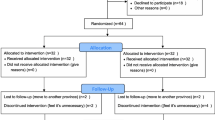Abstract
Background
Minimally invasive techniques in THA are intended to minimize periarticular muscle trauma. The lateral approach has a risk of partial gluteal insufficiency, while the anterolateral approach carries the risk of damaging the tensor fasciae latae through intermuscular nerve and compression injury.
Questions/purposes
We assessed the surgical influence of the anterolateral minimally invasive approach and the modified direct lateral approach on the tensor fasciae latae and gluteus medius.
Methods
We prospectively randomized 44 patients with primary coxarthrosis to receive a cementless THA via the anterolateral minimally invasive approach or the modified direct lateral approach. We performed clinical and MRI examinations preoperatively and 3 and 12 months postoperatively, including Harris hip and pain scores. MRI analysis included assessment of the tensor fasciae latae and gluteus medius with regard to fatty atrophy and changes in the muscle cross-sectional area.
Results
Clinical scores were similar in the two groups but a low-grade Trendelenburg sign was observed more frequently in the lateral group. MRI showed a pronounced, postoperative fatty atrophy of the anterior part of the gluteus medius more often; and a compensatory hypertrophy of the tensor fasciae latae occurred. Higher-grade atrophy of the tensor fasciae latae and gluteus medius did not occur with the anterolateral approach.
Conclusions
We found no increased damage to the tensor fasciae latae with the anterolateral approach. The lateral approach was associated with increased partial gluteus atrophy and a compensatory hypertrophy of the tensor fasciae latae. Based on fewer structural changes in the musculature, we recommend the anterolateral minimally invasive approach.





Similar content being viewed by others
References
Baker AS, Bitounis VC. Abductor function after total hip replacement. An electromyographic and clinical review. J Bone Joint Surg Br. 1989;71:47–50.
Bal BS, Lowe JA. Muscle damage in minimally invasive total hip arthroplasty: MRI evidence that it is not significant. Instr Course Lect. 2008;57:223–229.
Bauer R, Kerschbaumer F, Poisel S, Oberthaler W. The transgluteal approach to the hip joint. Arch Orthop Trauma Surg. 1979;95:47–49.
Bennett D, Ogonda L, Elliott D, Humphreys L, Beverland DE. Comparison of gait kinematics in patients receiving minimally invasive and traditional hip replacement surgery: a prospective blinded study. Gait Posture. 2006;23:374–382.
Berger RA. Total hip arthroplasty using the minimally invasive two-incision approach. Clin Orthop Relat Res. 2003;417:232–241.
Berry DJ, Berger RA, Callaghan JJ, Dorr LD, Duwelius PJ, Hartzband MA, Lieberman JR, Mears DC. Minimally invasive total hip arthroplasty. Development, early results, and a critical analysis. Presented at the Annual Meeting of the American Orthopaedic Association, Charleston, South Carolina, USA, June 14, 2003. J Bone Joint Surg Am. 2003;85:2235–2246.
Bertin KC, Rottinger H. Anterolateral mini-incision hip replacement surgery: a modified Watson-Jones approach. Clin Orthop Relat Res. 2004;429:248–255.
Charge SB, Rudnicki MA. Cellular and molecular regulation of muscle regeneration. Physiol Rev. 2004;84:209–238.
Chen DW, Hu CC, Chang YH, Yang WE, Lee MS. Comparison of clinical outcome in primary total hip arthroplasty by conventional anterolateral transgluteal or 2-incision approach. J Arthroplasty. 2009;24:528–532.
DiGioia AM, 3rd, Plakseychuk AY, Levison TJ, Jaramaz B. Mini-incision technique for total hip arthroplasty with navigation. J Arthroplasty. 2003;18:123–128.
Frndak PA, Mallory TH, Lombardi AV, Jr. Translateral surgical approach to the hip. The abductor muscle “split”. Clin Orthop Relat Res. 1993;295:135–141.
Goldstein WM, Branson JJ, Berland KA, Gordon AC. Minimal-incision total hip arthroplasty. J Bone Joint Surg. 2003;85 Suppl 4:33–38.
Gottschalk F, Kourosh S, Leveau B. The functional anatomy of tensor fasciae latae and gluteus medius and minimus. J Anatomy. 1989;166:179–189.
Goutallier D, Postel JM, Bernageau J, Lavau L, Voisin MC. Fatty muscle degeneration in cuff ruptures. Pre- and postoperative evaluation by CT scan. Clin Orthop Relat Res. 1994;304:78–83.
Gustke K. Surgical nuances to minimize muscle damage during the direct lateral approach in minimally invasive hip replacement. Instruc CourseLlect. 2008;57:235–241.
Hardinge K. The direct lateral approach to the hip. J Bone Joint Surg Br. 1982;64:17–19.
Ince A, Kemper M, Waschke J, Hendrich C. Minimally invasive anterolateral approach to the hip: risk to the superior gluteal nerve. Acta Orthop. 2007;78:86–89.
Jarvinen TA, Jarvinen TL, Kaariainen M, Kalimo H, Jarvinen M. Muscle injuries: biology and treatment. Am J Sports Med. 2005;33:745–764.
Karalaki M, Fili S, Philippou A, Koutsilieris M. Muscle regeneration: cellular and molecular events. In Vivo. 2009;23:779–796.
Kenny P, O’Brien CP, Synnott K, Walsh MG. Damage to the superior gluteal nerve after two different approaches to the hip. J Bone Joint Surg Br. 1999;81:979–981.
Kummer B. Is the Pauwels’ theory of hip biomechanics still valid? A critical analysis, based on modern methods. Ann Anat. 1993;175:203–210.
Laffosse JM, Accadbled F, Molinier F, Chiron P, Hocine B, Puget J. Anterolateral mini-invasive versus posterior mini-invasive approach for primary total hip replacement. Comparison of exposure and implant positioning. Arch Orthop Ttrauma Surg. 2008;128:363–369.
Laffosse JM, Chiron P, Molinier F, Bensafi H, Puget J. Prospective and comparative study of the anterolateral mini-invasive approach versus minimally invasive posterior approach for primary total hip replacement. Early results. Int Orthop. 2007;31:597–603.
Lin DH, Jan MH, Liu TK, Lin YF, Hou SM. Effects of anterolateral minimally invasive surgery in total hip arthroplasty on hip muscle strength, walking speed, and functional score. J Arthroplasty. 2007;22:1187–1192.
Lin YC, Chen CH, Huang HT, Su JY, Fu YC, Chang JK, Wang GJ. Minimally invasive total hip arthroplasty using a posterolateral approach: technique and preliminary results. Kaohsiung J Med Sci. 2007;23:611–617.
Maquet PGJ. Biomechanics of the Hip. Berlin, Germany: Springer-Verlag; 1985.
Mardones R, Pagnano MW, Nemanich JP, Trousdale RT. The Frank Stinchfield Award: muscle damage after total hip arthroplasty done with the two-incision and mini-posterior techniques. Clin Orthop Relat Res. 2005;441:63–67.
Maughan RJ, Watson JS, Weir J. Strength and cross-sectional area of human skeletal muscle. J Physiol. 1983;338:37–49.
Maughan RJ, Watson JS, Weir J. The relative proportions of fat, muscle and bone in the normal human forearm as determined by computed tomography. Clin Sci (Lond). 1984;66:683–689.
Meneghini RM, Pagnano MW, Trousdale RT, Hozack WJ. Muscle damage during MIS total hip arthroplasty: Smith-Petersen versus posterior approach. Clin Orthop Relat Res. 2006;453:293–298.
Meneghini RM, Smits SA, Swinford RR, Bahamonde RE. A randomized, prospective study of 3 minimally invasive surgical approaches in total hip arthroplasty: comprehensive gait analysis. J Arthroplasty. 2008;23(6 Suppl 1):68–73.
O’Brien DA, Rorabeck CH. The mini-incision direct lateral approach in primary total hip arthroplasty. Clin Orthop Relat Res. 2005;441:99–103.
Ogonda L, Wilson R, Archbold P, Lawlor M, Humphreys P, O’Brien S, Beverland D. A minimal-incision technique in total hip arthroplasty does not improve early postoperative outcomes. A prospective, randomized, controlled trial. J Bone Joint Surg. 2005;87:701–710.
Parratte S, Pagnano MW. Muscle damage during minimally invasive total hip arthroplasty: cadaver-based evidence that it is significant. Instruc CourseLect. 2008;57:231–234.
Pfirrmann CW, Notzli HP, Dora C, Hodler J, Zanetti M. Abductor tendons and muscles assessed at MR imaging after total hip arthroplasty in asymptomatic and symptomatic patients. Radiology. 2005;235:969–976.
Picado CH, Garcia FL, Marques W, Jr. Damage to the superior gluteal nerve after direct lateral approach to the hip. Clin Orthop Relat Res. 2007;455:209–211.
Rahman W, Richards CJ, Duncan CP. Surgical nuances to minimize muscle damage during the anterolateral intermuscular approach in minimally invasive hip replacement. Instruc Course Lect. 2008;57:243–247.
Ralston HJ, Inman VT, Strait LA, Shaffrath MD. Mechanics of human isolated voluntary muscle. Am J Physiol. 1947;151:612–620.
Roth A, Layher F, Venbrocks RA. Transgluteal mini-incision. Technique and our own results [in German]. Der Orthopade. 2006;35:744, 746–750.
Siebenrock KA, Rosler KM, Gonzalez E, Ganz R. Intraoperative electromyography of the superior gluteal nerve during lateral approach to the hip for arthroplasty: a prospective study of 12 patients. J Arthroplasty. 2000;15:867–870.
Soderman P, Malchau H. Is the Harris hip score system useful to study the outcome of total hip replacement? Clin Orthop Relat Res. 2001;384:189–197.
Svensson O, Skold S, Blomgren G. Integrity of the gluteus medius after the transgluteal approach in total hip arthroplasty. J Arthroplasty. 1990;5:57–60.
Torrance G. Social preferences for health states: an empirical evaluation of three measurement techniques. Socioecon Plann Sci. 1978;10:129–138.
Von Korff M, Ormel J, Keefe FJ, Dworkin SF. Grading the severity of chronic pain. Pain. 1992;50:133–149.
Wagers AJ, Conboy IM. Cellular and molecular signatures of muscle regeneration: current concepts and controversies in adult myogenesis. Cell. 2005;122:659–667.
Ward SR, Jones RE, Long WT, Thomas DJ, Dorr LD. Functional recovery of muscles after minimally invasive total hip arthroplasty. Instruc Course Lect. 2008;57:249–254.
Wenz JF, Gurkan I, Jibodh SR. Mini-incision total hip arthroplasty: a comparative assessment of perioperative outcomes. Orthopedics. 2002;25:1031–1043.
Woolson ST, Mow CS, Syquia JF, Lannin JV, Schurman DJ. Comparison of primary total hip replacements performed with a standard incision or a mini-incision. J Bone Joint Surg Am. 2004;86:1353–1358.
Yoon TR, Park KS, Song EK, Seon JK, Seo HY. New two-incision minimally invasive total hip arthroplasty: comparison with the one-incision method. J Orthop Sci. 2009;14:155–160.
Zhang XL, Shen H, Qin XL, Wang Q. Anterolateral muscle sparing approach total hip arthroplasty: an anatomic and clinical study. Chinese Med J. 2008;121:1358–1363.
Author information
Authors and Affiliations
Corresponding author
Additional information
Each author certifies that he or she has no commercial associations (eg, consultancies, stock ownership, equity interest, patent/licensing arrangements, etc) that might pose a conflict of interest in connection with the submitted article.
Each author certifies that his or her institution approved the human protocol for this investigation, that all investigations were conducted in conformity with ethical principles of research, and that informed consent for participation in the study was obtained.
About this article
Cite this article
Müller, M., Tohtz, S., Dewey, M. et al. Evidence of Reduced Muscle Trauma Through a Minimally Invasive Anterolateral Approach by Means of MRI. Clin Orthop Relat Res 468, 3192–3200 (2010). https://doi.org/10.1007/s11999-010-1378-5
Published:
Issue Date:
DOI: https://doi.org/10.1007/s11999-010-1378-5




